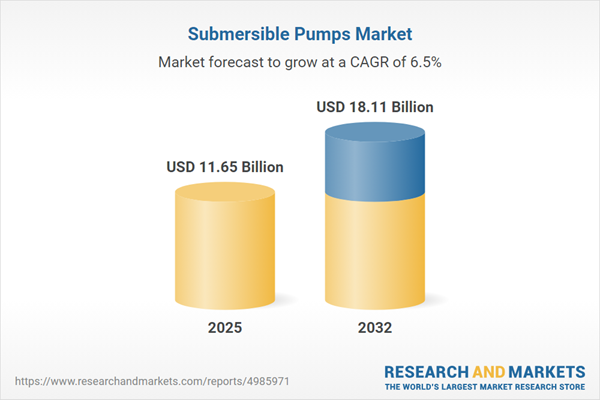Speak directly to the analyst to clarify any post sales queries you may have.
Senior leaders in the submersible pumps market navigate frequent shifts in technology, compliance standards, and operational demands. This report empowers executives by offering targeted, actionable intelligence to guide strategic planning and ensure optimal organizational responses as the landscape evolves.
Market Snapshot: Submersible Pumps Market Size and Dynamics
The global submersible pumps market is achieving consistent growth, driven by rising infrastructure investments and the need for advanced water management solutions. Rapid urbanization compels organizations to implement pump systems that reinforce operational reliability while adhering to evolving municipal and industrial benchmarks. Ongoing sector progress is shaped by infrastructure modernization, a push to surpass regulatory standards, and the adoption of digital solutions. Environmental regulations and a focus on sustainability influence market behavior, supporting the integration of cutting-edge pump technologies that address new requirements and customer expectations.
Scope & Segmentation: Comprehensive Market Coverage
- Type: Borewell pumps, deep well systems, open well pumps, and sewage pump solutions address the needs of agriculture, construction, manufacturing, and public utilities, offering flexible and robust performance in both standard and high-demand operations.
- Phase Type: Single-phase and three-phase submersible pumps cater to a broad range of applications—effectively supporting rural distribution systems alongside the demands of complex municipal and industrial projects.
- End Use Industry: The market serves agricultural irrigation, construction site dewatering, manufacturing, pharmaceuticals, chemicals, petrochemicals, mining, oil and gas, food processing, and energy. Reliable pump operation underpins process stability, compliance, and secure supply chain movement.
- Regional Coverage: Key markets include North America, Europe, the Middle East, Africa, and Asia-Pacific. Each region features distinct patterns in terms of modernization initiatives, technology adoption rates, and regulatory adjustments, shaping the speed and direction of market expansion.
- Companies Profiled: Leading suppliers—Grundfos A/S, Xylem Inc., Flowserve Corporation, Sulzer Ltd., KSB SE & Co. KGaA, Ebara Corporation, Franklin Electric Co. Inc., The Weir Group PLC, Kirloskar Brothers Limited, and Atlas Copco AB—are recognized for their innovation and regulatory alignment across diverse geographies.
Key Takeaways: Strategic Insights for Senior Decision-Makers
- Advanced seal designs and innovative materials improve pump durability, minimize unplanned downtime, and maintain consistent field performance over longer periods.
- Energy-efficient pump technologies advance sustainability efforts, decrease overall environmental impact, and help organizations meet operational cost targets as well as compliance objectives.
- Digital monitoring and predictive maintenance enable precise performance management and proactive risk reduction, assisting organizations to avoid costly operational breaks.
- Integration of renewable or hybrid energy solutions into pump systems extends adaptability, particularly in markets experiencing power supply variability, while opening new avenues for cost control and deployment expansion.
- Modular architectures and partnerships support swift responsiveness to evolving regulations and provide organizations with flexible pathways for operational decisions.
- A strong local supplier base and effective material sourcing reinforce supply chain continuity and foster timely project delivery—even in the face of market volatility.
Tariff Impact: Navigating Supply Chain Realities
Adjustments in tariffs affecting submersible pump components are prompting a shift toward more localized sourcing and increased domestic manufacturing. These actions shore up supply chain resilience, enhance alignment with regional compliance requirements, and help minimize potential disruptions triggered by evolving global trade policies.
Methodology & Data Sources
This report synthesizes insights from executive interviews, technical expert evaluations, site observations, and continuous monitoring of regulatory trends and intellectual property activity. Each finding is benchmarked against industry-accepted datasets to ensure both accuracy and practical relevance for sector leaders.
Why This Report Matters: Strategic Value for Senior Decision-Makers
- Enables executives to prioritize investment in pump innovation while remaining responsive to shifting regulatory and commercial realities.
- Illuminates the relationship between supply chain strength, sustainable operations, and risk mitigation strategies, supporting confident long-term planning.
- Guides senior leaders in building adaptive strategies for products and operations that align with ongoing changes in the submersible pumps market.
Conclusion
This report equips senior decision-makers with foresight to anticipate market shifts, strengthen organizational adaptability, and maintain sustained performance in a changing submersible pumps sector.
Additional Product Information:
- Purchase of this report includes 1 year online access with quarterly updates.
- This report can be updated on request. Please contact our Customer Experience team using the Ask a Question widget on our website.
Table of Contents
3. Executive Summary
4. Market Overview
7. Cumulative Impact of Artificial Intelligence 2025
Companies Mentioned
The companies profiled in this Submersible Pumps market report include:- Grundfos A/S
- Xylem Inc.
- Flowserve Corporation
- Sulzer Ltd.
- KSB SE & Co. KGaA
- Ebara Corporation
- Franklin Electric Co., Inc.
- The Weir Group PLC
- Kirloskar Brothers Limited
- Atlas Copco AB
Table Information
| Report Attribute | Details |
|---|---|
| No. of Pages | 196 |
| Published | October 2025 |
| Forecast Period | 2025 - 2032 |
| Estimated Market Value ( USD | $ 11.65 Billion |
| Forecasted Market Value ( USD | $ 18.11 Billion |
| Compound Annual Growth Rate | 6.5% |
| Regions Covered | Global |
| No. of Companies Mentioned | 11 |









